MIGHTY NINETY
Chapter 18: OPERATION DETACHMENT part 2
USS ASTORIA CL-90 at Iwo Jima on D+3
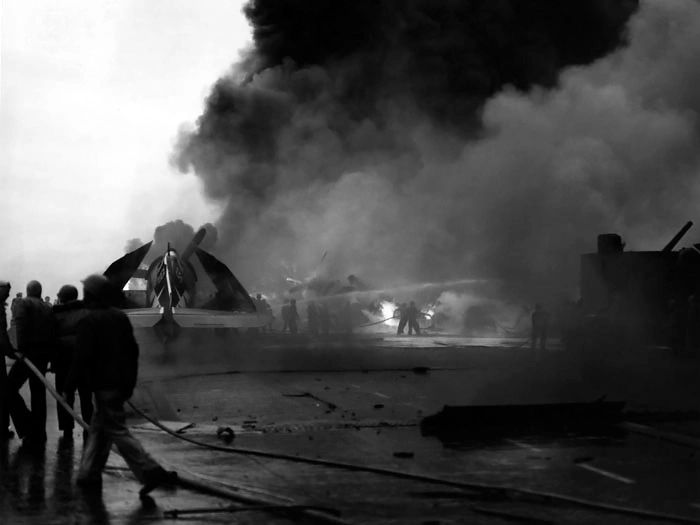
Above and below: Firefighting efforts by damage control parties on the flight deck of USS SARATOGA CV-3 in the evening of 21 February 1945.
-U.S. Navy photo in Brent Jones collection
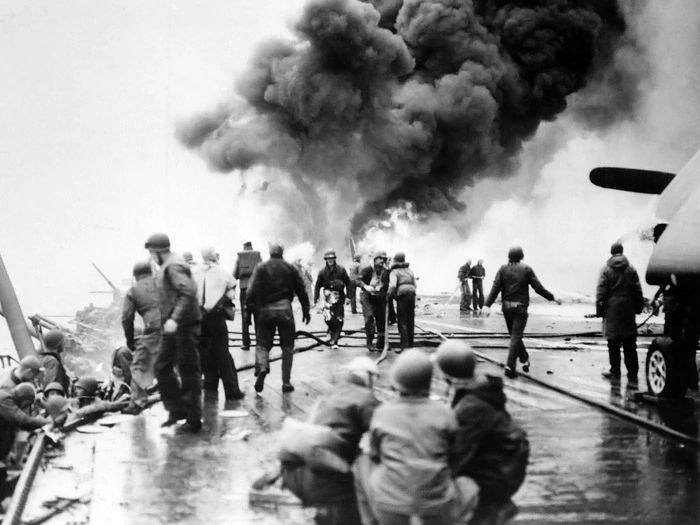
-U.S. Navy photo in Brent Jones collection
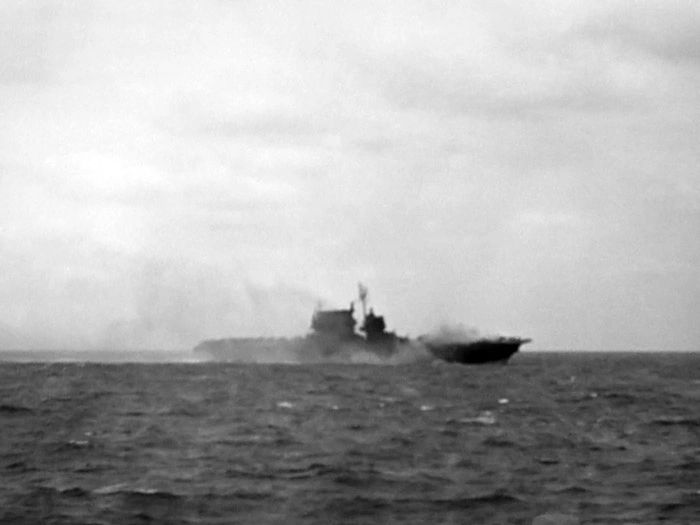
USS SARATOGA CV-3 as fires are brought under control in the evening of 21 February 1945.
-U.S. Navy photo in Brent Jones collection
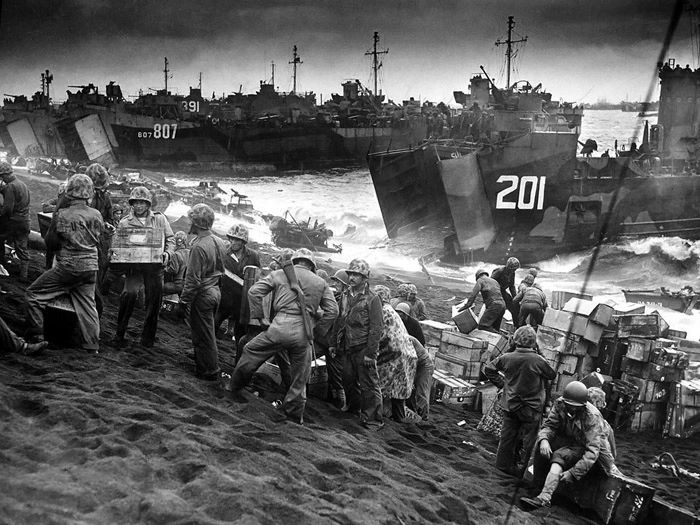
Unloading of supplies continues into the evening in heavy surf, circa 21 February 1945. The landing beaches were closed most of the day due to poor conditions.
-U.S. Coast Guard photo in Brent Jones collection

As night fell, call fire responsibility for USS ASTORIA, PASADENA and BOSTON was transferred under the control of a Marine shore party. The Marines called for support throughout the night as the Japanese made repeated counter-attacks.
-USMC photo in Brent Jones collection

A grid map of Iwo Jima showing the call-fire requests of USS ASTORIA CL-90 on the night of 21-22 February 1945. Most requests were for starshell illumination so the Marines could see their attackers. In the early morning ASTORIA also provided direct illumination from her 36" main lamps.
-grid map created by Brent Jones
22 February 1945: D+3
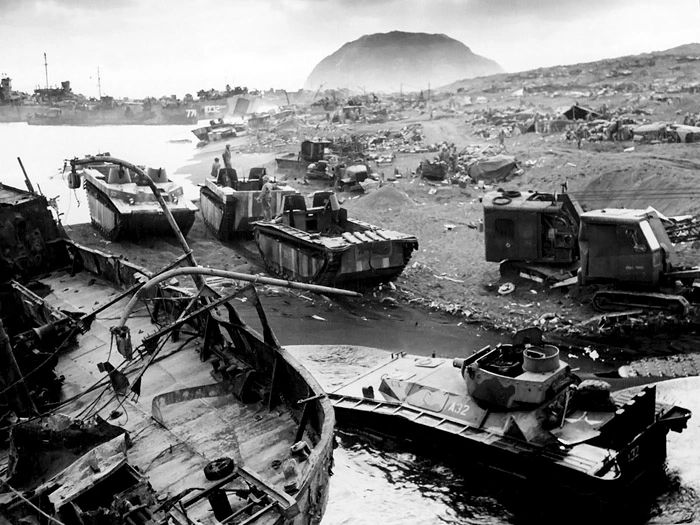
The Iwo landing beaches clogged with destroyed equipment, circa 22 January 1945. Rain and foul weather continued to hamper beach operations on D+3.
-Robert M. Warren photo reproduced from Wikimedia Commons
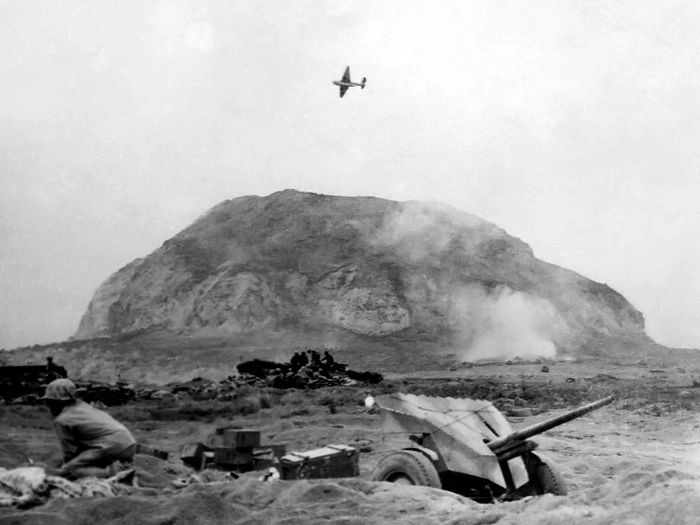
A carrier-based TBM Avenger drops ordnance at the base of Suribachi circa 22 February 1945. The Marines were making progress bringing their artillery inland for additional fire support.
-USMC photo in Brent Jones collection

Above and below: ASTORIA and Task Unit 54.1.18 temporarily suspend their fire as carrier planes drop bombs over inland targets.
-photo taken by and courtesy of Herman Schnipper
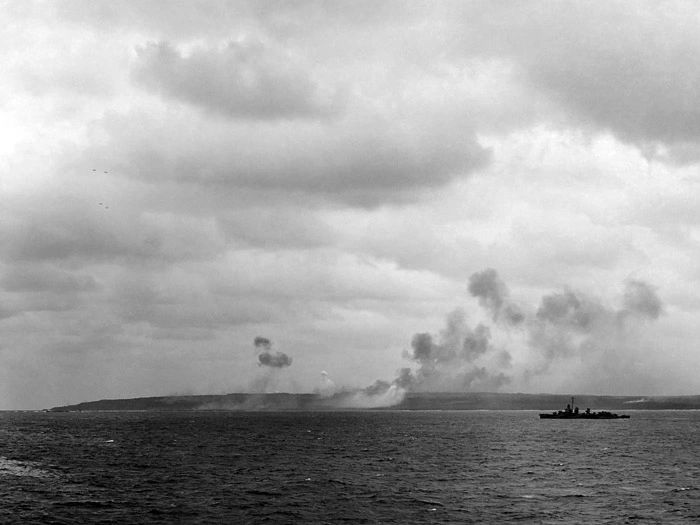
-photo taken by and courtesy of Herman Schnipper

The only known photograph of USS ASTORIA CL-90 firing on Iwo Jima taken from another ship. PASADENA and ASTORIA are in their fire support position at left. The entire length of Iwo Jima is visible with Mt. Suribachi rising at right in this image taken from USS DENNIS DE-405.
-Edward J. Cafferty photo courtesy of Jeff von Holten

ASTORIA sailors in cold weather gear during the 26-hour bombardment. Note the man at lower left reading and covering his ears from the noise.
-photo taken by and courtesy of Herman Schnipper

Men at Air Emergency Stations watch the progress of 5th Division Marines ashore. "It was like having a ringside seat" was a sentiment conveyed by many sailors.
-photo taken by and courtesy of Herman Schnipper
USS ASTORIA CL-90 at Iwo Jima on D+3

Above and below: Firefighting efforts by damage control parties on the flight deck of USS SARATOGA CV-3 in the evening of 21 February 1945.
-U.S. Navy photo in Brent Jones collection

-U.S. Navy photo in Brent Jones collection

USS SARATOGA CV-3 as fires are brought under control in the evening of 21 February 1945.
-U.S. Navy photo in Brent Jones collection

Unloading of supplies continues into the evening in heavy surf, circa 21 February 1945. The landing beaches were closed most of the day due to poor conditions.
-U.S. Coast Guard photo in Brent Jones collection

As night fell, call fire responsibility for USS ASTORIA, PASADENA and BOSTON was transferred under the control of a Marine shore party. The Marines called for support throughout the night as the Japanese made repeated counter-attacks.
-USMC photo in Brent Jones collection

A grid map of Iwo Jima showing the call-fire requests of USS ASTORIA CL-90 on the night of 21-22 February 1945. Most requests were for starshell illumination so the Marines could see their attackers. In the early morning ASTORIA also provided direct illumination from her 36" main lamps.
-grid map created by Brent Jones
22 February 1945: D+3

The Iwo landing beaches clogged with destroyed equipment, circa 22 January 1945. Rain and foul weather continued to hamper beach operations on D+3.
-Robert M. Warren photo reproduced from Wikimedia Commons

A carrier-based TBM Avenger drops ordnance at the base of Suribachi circa 22 February 1945. The Marines were making progress bringing their artillery inland for additional fire support.
-USMC photo in Brent Jones collection

Above and below: ASTORIA and Task Unit 54.1.18 temporarily suspend their fire as carrier planes drop bombs over inland targets.
-photo taken by and courtesy of Herman Schnipper

-photo taken by and courtesy of Herman Schnipper

The only known photograph of USS ASTORIA CL-90 firing on Iwo Jima taken from another ship. PASADENA and ASTORIA are in their fire support position at left. The entire length of Iwo Jima is visible with Mt. Suribachi rising at right in this image taken from USS DENNIS DE-405.
-Edward J. Cafferty photo courtesy of Jeff von Holten

ASTORIA sailors in cold weather gear during the 26-hour bombardment. Note the man at lower left reading and covering his ears from the noise.
-photo taken by and courtesy of Herman Schnipper

Men at Air Emergency Stations watch the progress of 5th Division Marines ashore. "It was like having a ringside seat" was a sentiment conveyed by many sailors.
-photo taken by and courtesy of Herman Schnipper

A grid map of Iwo Jima showing the call-fire requests of USS ASTORIA CL-90 on 22 February 1945. ASTORIA and Task Unit 54.1.18 were instrumental in beating back a strong counter-attack against American positions in the early afternoon.
-grid map created by Brent Jones
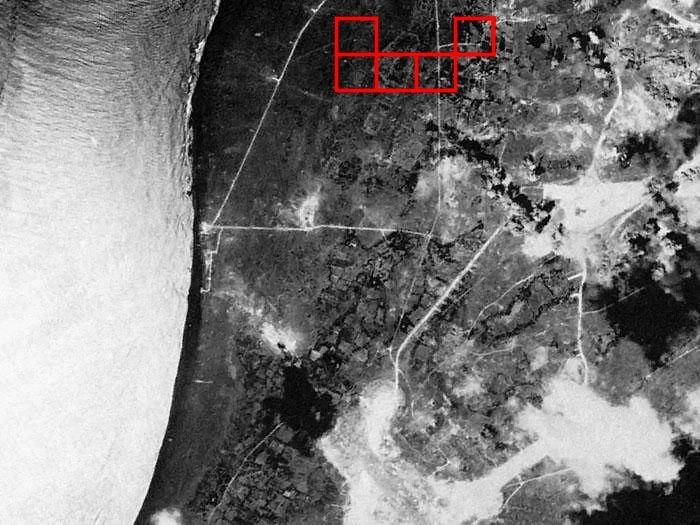
An aerial view of ASTORIA's target area taken on 22 February 1945. The 5th Marine Division lines lay roughly across the road visible at center. The red-marked grid references were where the Japanese counter-attack originated. Motoyama airfield no. 1 is visible at bottom, airfield no. 2 at upper right.
-U.S. Navy photo in Brent Jones collection

4th Division Marines using a shell crater as a foxhole during their advance through the airfields.
-USMC photo in Brent Jones collection

A dramatic photograph of the Marine advance up the island. The image was taken by W. Eugene Smith, who departed BUNKER HILL and came ashore following the opening days of the invasion.
-W. Eugene Smith photo in LIFE/Getty archive
After 26 hours of continuous fire support, Task Unit 54.1.18 was dissolved and Cruiser Division 17 retired from Iwo Jima for rest. The success of their bombardment is recounted in ASTORIA's cruise book:
For two days and one night we sent 6” and 5” shells into our assigned targets where they would do the most good. Our fire was accurate and when we shoved off we had accounted for several pillboxes, gun emplacements and had broken up a [Japanese] counter-attack. It was in this engagement that we destroyed our first plane. The main battery demolished it with a stray shell while firing on a [Japanese] emplacement.

Destroyed Japanese planes in the ruins of Motoyama airfield no.1. It was another four days before the first American plane would land on the airfield under heavy fire. The Marines were not able to utilize their own spotter aircraft until the second week of the invasion.
-W. Eugene Smith photo in LIFE/Getty archive
In her first action, ASTORIA had fired 3000 rounds during shore bombardment for advancing U.S. Marines and Navy personnel at Iwo Jima. Although the ships of Cruiser Division 17 pulled away from Iwo Jima unscathed, VCS-17 suffered a combat loss: One of WILKES-BARRE's OS2N-1 Kingfishers performed a forced landing due to engine failure and was a total loss.

ASTORIA sailors stack spent 6" shell casings for transfer to an auxiliary ship. The precious brass was retained for reuse in the war effort.
-photo taken by and courtesy of Herman Schnipper

USS ASTORIA moves away from Iwo Jima. Following her 26-hour shore bombardment in which the ship fully depleted her ammunition supply, she rejoined the Fast Carrier Task Force.
-photo taken by and courtesy of Herman Schnipper
23 February 1945 D+4
While the reconstituted Fast Carrier Task Force steamed toward Japan for a second round of air raids on Tokyo, their efforts at Iwo were paying off. Hours after ASTORIA and her task unit left Iwo Jima, elements of the 5th Marine Division reached the top of Mt. Suribachi. Two successive flags were raised through the course of the day and the most famous photograph of the war was taken.

The uncropped image that became the most famous photograph of World War II, taken atop Mount Suribachi on D+4, 23 February 1945. Within days half the men in the photograph were killed in action.
-Joe Rosenthal photo in NARA record group 80-G

An image taken a second later shows the rest of the story out of frame in Rosenthal's photo. As the second, larger flag is secured in the background, the original flag over Suribachi is lowered.
-Robert R. Campbell photo in LIFE/Getty archive

A haggard Joey Fubar following two days at General Quarters off Iwo Jima. The cartoon ran in the ASTORIA morning press the same morning the flag was raised over Mt. Suribachi. Back in the United States, it was still February 22nd--George Washington's birthday, a federal holiday.
-Joe Aman cartoon courtesy of Herman Schnipper
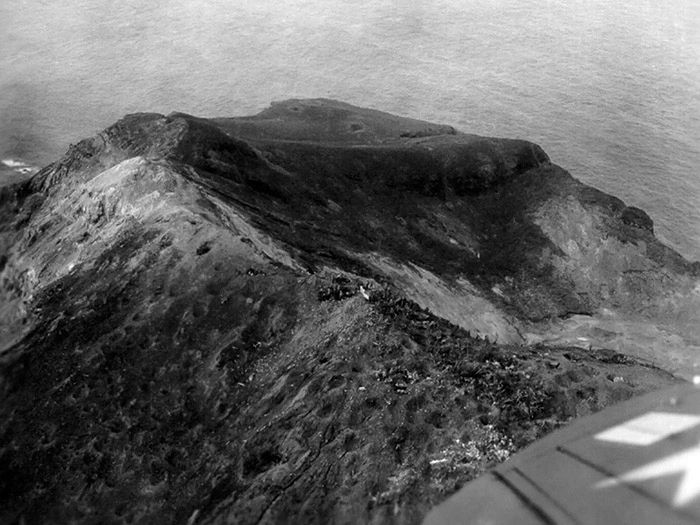
An aerial view of Mt. Suribachi circa 23 February 1945. Taken from a USS PENSACOLA CA-24
floatplane, the flag is visible at center surrounded by Marines.
-U.S. Navy photo reproduced from USS PENSACOLA cruise book
While the Rosenthal photo came to symbolize victory at Iwo Jima for the American public, in reality the fighting continued for several more weeks. Although Suribachi had fallen, many more would lose their lives before the island was secured.

Above and below: While Old Glory flew over Mt. Suribachi, the fighting continued northward up the island. USS ASTORIA had made a significant contribution, providing fire support during the critical period when Marines secured their beachhead and consolidated lines of advance. The progress from D+3 forward was in part a result of these naval gunfire missions supporting the Marines on the ground.
-U.S. Navy photo in LIFE/Getty archive

-USMC photo in Brent Jones collection
Continue to CHAPTER 19: OPERATION JAMBOREE Part 2

CLICK ON PHOTOS TO ADVANCE TO NEXT CHAPTER
BACK TO SHIP HISTORY
http://commons.Wikimedia.org/wiki/Main_Page Wikimedia Commons image database.
http://earth.Google.com/ Google Earth.
Jones, Brent. Private photo and document collection.
LIFE images reproduced at http://images.google.com
MIGHTY NINETY: USS ASTORIA CL-90 cruise book. 1946.
Morison, Samuel Eliot. History of
Schnipper, Herman. Private photo and document collection.
Wheeler, Keith. The Road to Tokyo. Chicago, IL: Time-Life Books, 1979.
www.archives.gov National Archives and Records Administration WWII photo archive.
http://www.dondennisfamily.com/ussdennis/index.html. USS DENNIS DE-405 website.
